Yoga For Upper Back Pain To Release Tension In Body:
Jump To:
This yoga for upper back pain helps you release tension and keep the muscles and joints mobilized.
Back pain has become a widespread concern with many of us refusing to exercise, dance or hike because we feel our backs are too delicate. Regular practice of the following yoga for upper back pain relaxes the muscles of the lower back, removing stiffness and pain. When the body is free from pain, the self-imposed limitations of the mind also break leaving you free to explore new horizons.
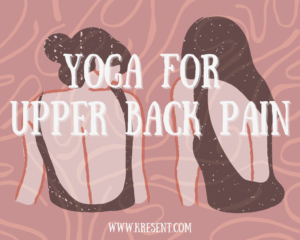
Upper Back Pain Causes:
The upper back pain may also be caused due to poor posture such as sitting with a rounded back, shoulders hunched forward can put too much stress on the back muscles. Importance of good posture is to be known to avoid the uneasiness of the muscles. As bad posture leads to stress, you can relieve stress through healthy lifestyle tips, pranayama for stress and yoga for stress.
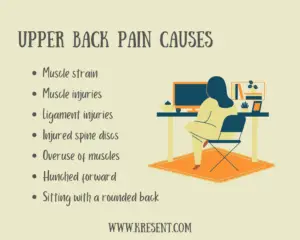
The others reasons can be overuse, muscle strain, or injury to the muscles, ligaments, and discs that support your spine.
Upper Back Pain Tips:
- Sleep on a medium-firm mattress.
- Pay attention to your posture.
- Ice the area and later apply heat.
- With the importance of stretching strengthen the back muscles by doing exercises such as yoga, yoga for shoulders.
Yoga For Upper Back Pain:
Here is 3 daily yoga for upper back pain to relieve stress and tension from the shoulders, upper back, and middle back and ease the mobility.
Tadasana (Standing Pose):
This yoga pose with regular practice opens the upper back, release tension from the shoulders. Expand the chest and improve the breath capacity.
Tadasana looks like simple standing but there is a particular way to set every part of the body in the asana. Let’s get into detailed steps of tadasana.
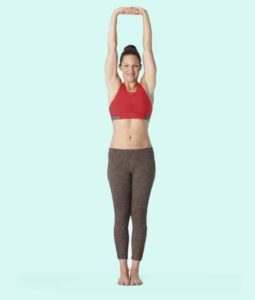
Tadasana Steps:
At first, practice the tadasana with standing against the wall to maintain the correct posture, with hips towards the wall and the ankles a few inches away from it.
- Stand with the feet hip-distance apart grounding the feet. Lift the energy from the ground up towards the torso.
- Gently extend the spine maintaining natural curve, by tucking the tailbone down towards the earth and the pelvis in towards the body.
- Roll the shoulders up towards the ears and drop them down towards the hips. Focus on the breath.
- Inhale; raise the arms up towards the sides, with the shoulders touching the wall, and the palms facing forwards, stretching and extending the torso.
- Exhale; bring the arms down. Repeat 5 to 10 times; relax.
- Inhale; raise both the arms up towards the ceiling with the palms parallel, make sure the shoulders are pressing down towards the hips.
- Exhale; bring the arms down towards the body. Repeat 5 to 10 times; relax.
Gomukhasana (Cow Face Pose):
This yoga for upper back pain strengthens the shoulders and extends the upper spine, releasing tension around the shoulders.
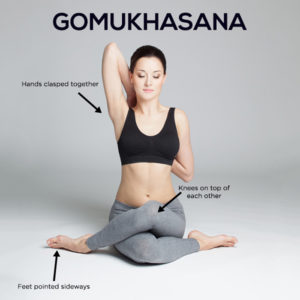
Gomukhasana Steps:
At first, practice the tadasana with standing against the wall to maintain the correct posture, with hips towards the wall and the ankles a few inches away from it.
- Stand with the feet hip-distance apart grounding the feet. Lift the energy from the ground up towards the torso.
- Tuck the tailbone down towards the earth and the pelvis in towards the body, creating an extension through the spine, keeping its natural curvature.
- Roll the shoulders up towards the ears and drop them down towards the hips. Focus on the breath.
- Inhale; lift the right arm up, above the head. Exhale; bend the right arm from the elbow and take it behind the upper spine, palm facing the spine.
- Inhale; bend the left arm at the elbow and take it behind the middle back, palm facing away from the spine.
- Try and lock the right palm facing towards the spine and the left hand facing away from the spine, with the fingers together and bent like a hook.
- Hold the pose breathing deeply, extending the spine, and opening the chest with every inhalation.
- Maintain the opening with every exhalation. Hold the pose for 5 to 10 breaths; release.
Repeat on the left arm; relax.
Parighasana (Gate Pose):
The parighasana pose increases the lateral extension and opens the sides of the upper chest and shoulders.
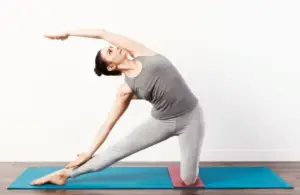
Parighasana Steps:
- Stand on the knees with your toes curled in or out, hip-distance apart.
- Stretch the left foot out three feet to the side with the right hip and knee in line.
- With both the arms on the waist, hold this pose breathing deeply.
- Inhale; raise both the arms, palms parallel.
- Exhale; bend to the left side extending the spine, with the left arm go down towards the thighs and right arm extended straight towards the left, letting the torso go down towards the left.
- Hold the pose for 5 to 8 breaths.
- Inhale; release the pose.
Repeat on the other side.
Yoga Mudrasana (Union Pose):
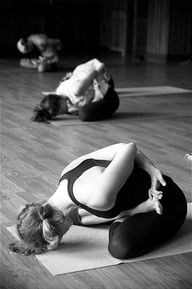
Yoga Mudrasana Steps:
You will need a yoga mat or towel, a flat cushion, and a rolled-up towel. This is best done first thing in the morning and just before going to bed.
- Sit cross-legged on the mat.
- If your body feels stiff, sit on a cushion so that you have some back support.
- Place the rolled-up towel in front of you.
- Push your shoulders back and bring your chin parallel to the floor.
- Clasp your right wrist with your left hand behind your back.
- Exhale, keep your spine straight and move forward to place your forehead on the towel.
- Move slowly. Go to the limit your body is letting you right now.
Hold the pose for 10 breaths.
If your lower back is too stiff, move forward and come back up as you exhale and inhale respectively at least seven times.
Besides yoga and exercising, diagnosing the actual cause is also important. sometimes, the right course of action such as therapy or rehabilitation may be needed. If the pain is severe, it may be difficult to continue exercising or start on a rehabilitation programme immediately. The pain has to be reduced by at least 60-70% before you begin any exercise programme. It is best to let the doctor guide you with physiotherapy exercises in such cases.
Take Away:
The yoga for upper body pain helps relieve the stress and tension from the upper body. You may also check your posture, as it can be one of the reasons that your back hurts.
FAQs
Which yoga is good for upper back pain?
Cobra Pose: Lying down on your stomach, you use your arms to slowly raise your upper body. This provides great shoulder relief and builds strength. Half Lord of The Fishes: Performed while seated, this pose provides a twisting motion to energize the spine, shoulders, and neck. It looks like a pretzel pose.
Is yoga good for back knots?
Gentle stretching, yoga, pilates and swimming can help your muscles loosen up and strengthen at the same time. Dehydration causes a myriad of problems, including muscular injuries and knots.
Should I do yoga if my upper back hurts?
If you’re dealing with back pain, yoga may be just what the doctor ordered. Yoga is a mind-body therapy that’s often recommended to treat not only back pain but the stress that accompanies it. The appropriate poses can relax and strengthen your body.
Can yoga hurt upper back?
You might be surprised to hear this, but a 2014 study found that back pain is the most often reported medical complaint among those who practice yoga.
What causes tension in upper back?
Upper back pain is usually caused by soft tissue injuries, such as sprains or strains, or muscle tension caused by poor posture or looking downward for long periods. Poor posture and text neck can combine to wreck your upper back.
What causes upper back tightness?
Overuse, muscle strain, or injury to the muscles, ligaments, and discs that support your spine. Poor posture. Pressure on the spinal nerves from certain problems, such as a herniated disc.
Why do I get knots between my shoulder blades?
The most common source of muscle knots is the trapezius muscle. This muscle makes a triangle-like shape from the neck to the middle of the back and the shoulder.
What causes upper back pain in females?
Poor posture, like slouching or pushing the head forward while sitting or standing, causes misalignment of the spine.
How should I sleep to reduce upper back pain?
The best position to avoid back pain is lying flat on your back. Even so, many people find it the hardest way to enjoy deep sleep.
